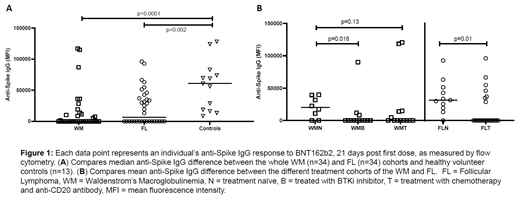Abstract
Introduction
Lymphoid malignancies are a risk factor for severe COVID-19. Vaccination with BNT162b2 protects the general population from severe disease, but recent studies have shown limited seroconversion after vaccination in patients with lymphoid malignancy. This reduced response is likely related to disease and treatment factors altering both humoral and cellular immunity. Assessing response in patients with the indolent lymphomas, Waldenström's Macroglobulinaemia (WM) and Follicular Lymphoma (FL), including cohorts on differing treatment regimens, may help elucidate some of these factors. Australia has had low prevalence of SARS-CoV-2 infection to date, affording a unique opportunity to assess efficacy to vaccination without the confounding impact of endemic infection.
Methods
Patients with WM and FL and controls were enrolled in a prospective study of immune response after two doses of BNT162b2 administered 21 days apart. The study had Human Research Ethics Committee approval and all patients gave informed consent prior to participation. Recruitment was targeted to obtain comparable proportions of controls to treatment cohorts. PBMC and sera were collected from participants immediately prior to the first dose (T1), at day 21 immediately prior to the second dose (T2), and day 49 (+/- 7d) (T3). Immune response was measured by: flow cytometric detection of anti-SARS-CoV-2 spike antibodies (ASAb), performed using our recently validated flow cytometric live cell assay (Tea et.al. PLoS Medicine 2021) with increased sensitivity compared to currently available commercial ELISAs; live virus neutralisation to a panel of SARS-CoV-2 variants of concern; and CD4+and CD8+ antigen-specific T cell responses. Statistical analysis of medians between cohorts were compared by the Mann-Whitney non-parametric test using Graphpad Prism. Initial ASAb IgG data for T1 and T2 is presented here. Complete immune response data at all time points will be available for the ASH meeting.
Results
Eighty-five participants received their first dose of BNT162b2 from 18 May 2021 to 7 June 2021 with a second dose 21 days later: 72 lymphoma patients (WM and FL) and 13 age-matched healthy volunteers (controls). Of 37 with WM [19 (51.3%) female, median 71 years (IQR 63-74)] 9 were treatment naïve (WMN), 15 had received rituximab-chemotherapy (WMT), and 13 were currently treated with a Bruton Tyrosine Kinase inhibitor (BTKi): 5 ibrutinib, 8 zanubrutinib (WMB). Of 35 patients with FL [16 (45.7%) female, median 65 years (IQR 54-71)], 11 were treatment naïve (FLN), and 24 had received rituximab-chemotherapy (FLT). Of the 13 controls 8 (61.5%) were female, median age 72 years (IQR 57-74)].
No participants had detectable ASAb at T1, confirming no prior SARS-CoV-2 exposure. Figure 1 shows ASAb results at T2. The median mean fluorescence intensity (MFI) of healthy controls: 60802 (IQR 17565 -78443), is higher than all WM: 0 (IQR 0 - 15010) p<0.0001, and all FL patients: 1687 (IQR 0 - 25421) p=0.002, Fig 1A. The median MFI of controls was higher than WMN (p=0.036), but not higher than FLN (p=0.28). The median MFI of WMN: 20074 (IQR 5421 - 35695), is higher than WMB: 0 (IQR 0 - 4217) p=0.018, but not significantly higher than WMT: 0 (IQR 0 - 14356) p=0.13, Fig 1B. Median MFI of FLN: 31476 (IQR 19351 - 51317), is higher than FLT: 0 (IQR 0 - 32849) p=0.01, Fig 1B.
Conclusion
These early serological data show measurable ASAb in all healthy controls 21 days post first dose of BNT162b2 vaccination. Treatment naïve patients had a better response than treated patients, and this did not differ significantly to healthy controls in the FL cohort. In WM, patients on BTKi had a significantly reduced response compared to treatment-naïve patients. This same reduction was not observed in the chemotherapy-rituximab cohort, but the characteristics of early responders versus non-responders, including time since last therapy, is being analysed. FL patients treated with chemotherapy-rituximab had a significantly reduced response compared to the treatment-naïve cohort.
Time constraints before the abstract submission deadline prevented reporting of all mature vaccination response data. Measurement of ASAb one month after second vaccination, live virus neutralisation to a panel of SARS-CoV-2 variants of concern, and CD4+ and CD8+ antigen-specific T cell responses at T1, T2 and T3, to fully characterise the immune response to BNT162b2, will be reported at the ASH meeting.
Rankin: Novo Nordisk Pharmaceuticals: Other: Travel reimbursement to attend haemophilia academy. Kelleher: CSL/Sequiris: Honoraria; Aegros and CSL: Consultancy; Merck: Speakers Bureau; Aegros, CSL, Merek: Membership on an entity's Board of Directors or advisory committees. Brilot: Novartis: Research Funding; Biogen, Merck: Honoraria. Trotman: beigene: Research Funding; roche: Research Funding; PCYC: Research Funding; BMS: Research Funding; TAKEDA: Research Funding; JANSSEN: Research Funding.


